| This article needs additional citations for verification. Please help improve this article by adding citations to reliable sources. Unsourced material may be challenged and removed. Find sources: "Menhaden" – news · newspapers · books · scholar · JSTOR (October 2010) (Learn how and when to remove this message) |
| Menhaden | |
|---|---|
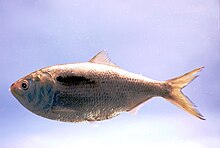
| |
| Brevoortia patronus | |
| Scientific classification | |
| Domain: | Eukaryota |
| Kingdom: | Animalia |
| Phylum: | Chordata |
| Class: | Actinopterygii |
| Superorder: | Clupeomorpha |
| Order: | Clupeiformes |
| Groups included | |
| |
| Cladistically included but traditionally excluded taxa | |
 Gulf menhaden, Brevoortia patronus
Gulf menhaden, Brevoortia patronus Atlantic menhaden, Brevoortia tyrannus
Atlantic menhaden, Brevoortia tyrannus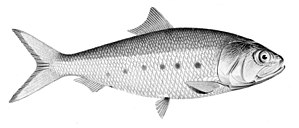 Pacific menhaden, Ethmidium maculatum
Pacific menhaden, Ethmidium maculatum
Menhaden, also known as mossbunker, bunker, and "the most important fish in the sea", are forage fish of the genera Brevoortia and Ethmidium, two genera of marine fish in the order Clupeiformes. Menhaden is a blend of poghaden (pogy for short) and an Algonquian word akin to Narragansett munnawhatteaûg, derived from munnohquohteau ("he fertilizes"), referring to their use of the fish as fertilizer. It is generally thought that Pilgrims were advised by Tisquantum (also known as Squanto) to plant menhaden with their crops.
Description
Menhaden are flat and have soft flesh and a deeply forked tail. They rarely exceed 15 inches (38 cm) in length, and have a varied weight range. Gulf menhaden and Atlantic menhaden are small oily-fleshed fish, bright silver, and characterized by a series of smaller spots behind the main humeral spot. They tend to have larger scales than yellowfin menhaden and finescale menhaden. In addition, yellowfin menhaden tail rays are a bright yellow in contrast to those of the Atlantic menhaden.
Taxonomy
| This article is part of a series on |
| Commercial fish |
|---|
| Large predatory |
| Forage |
| Demersal |
| Mixed |
Recent taxonomic work using DNA comparisons have organized the North American menhadens into large-scaled (Gulf and Atlantic menhaden) and small-scaled (Finescale and Yellowfin menhaden) designations.
The menhaden consist of two genera and seven species:
- Genus Brevoortia T. N. Gill, 1861
- Brevoortia aurea (Spix & Agassiz, 1829) (Brazilian menhaden)
- Brevoortia gunteri Hildebrand, 1948 (Finescale menhaden)
- Brevoortia patronus Goode, 1878 (Gulf menhaden)
- Brevoortia pectinata (Jenyns, 1842) (Argentine menhaden)
- Brevoortia smithi Hildebrand, 1941 (Yellowfin menhaden)
- Brevoortia tyrannus (Latrobe, 1802) (Atlantic menhaden)
- Genus Ethmidium W. F. Thompson, 1916
- Ethmidium maculatum (Valenciennes, 1847) (Pacific menhaden)
Distribution
- Finescale menhaden range from the Yucatán to Louisiana.
- Yellowfin menhaden range from Louisiana to Virginia.
- Gulf menhaden range from the Yucatán Peninsula, Mexico, to Tampa Bay, Florida.
- Atlantic menhaden range from Jupiter Inlet, Florida, to Nova Scotia; Atlantic menhaden seasonally migrate along the coast; in June, mature adults typically are in the northern portion of the coastline with sub-adults and juveniles located in the southern portion.
- The various species of menhaden occur anywhere from estuarine waters outward to the continental shelf; menhaden grow in less saline waters of estuaries and may be found in bays and lagoons, as well as at river mouths; adults appear to prefer water temperatures near 18 °C.
Ecology
Menhaden are filter feeders that travel in large, slow-moving, and tightly packed schools with open mouths. Filter feeders typically take into their open mouths "materials in the same proportions as they occur in ambient waters". Menhaden have two main sources of food: phytoplankton and zooplankton. A menhaden's diet varies considerably over the course of its lifetime, and is directly related to its size. The smallest menhaden, typically those under one year old, eat primarily phytoplankton. After that age, adult menhaden gradually shift to a diet comprised almost exclusively of zooplankton.
Menhaden are omnivorous filter feeders, feeding by straining plankton and algae from water. Along with oysters, which filter water on the seabed, menhaden play a key role in the food chain in estuaries and bays. Atlantic menhaden are an important link between plankton and upper level predators. Because of their filter feeding abilities, "menhaden consume and redistribute a significant amount of energy within and between Chesapeake Bay and other estuaries, and the coastal ocean." Because they play this role, and their abundance, menhaden are an invaluable prey species for many predatory fish, such as striped bass, bluefish, mackerel, flounder, tuna, drums, and sharks. They are also a very important food source for many birds, including egrets, ospreys, seagulls, northern gannets, pelicans, and herons.
In 2012, the Atlantic States Marine Fisheries Commission declared that the Atlantic menhaden was depleted due to overfishing. The decision was driven by issues with water quality in the Chesapeake Bay and failing efforts to re-introduce predator species, due to lack of menhaden on which they could feed.
Menhaden are crucial not only because of their keystone species-status in the food web, but also because of their ecological services. The way menhaden filter feed on phytoplankton helps to mitigate toxic algal blooms. These algal blooms, which are often detrimental to a number of fish, bird, and marine mammal species, create hypoxic conditions. The phytoplankton being preyed upon are photosynthetic organisms, converting sunlight into energy which is then transferred to menhaden and then to bigger species of fish or other larger marine organisms such as birds or mammals. The consequence of this behavior is that if menhaden are eliminated or significantly decreased, there are limited means of energy transfer among trophic levels – making menhaden a true keystone species with ecological services that are invaluable to humans.
Habitat
Menhaden are a pelagic schooling fish that migrate inshore during the summer and off-shore in the winter months. The juvenile and larval menhaden migrate to shore and inland waterways through currents during summer months to grow while feeding on the phytoplankton and eventually zooplankton once they have matured. Commercially caught menhaden have been recorded in waters of around 5 to 24 ‰, as well as in hypersaline waters around 60 ‰.
Reproduction
Menhaden reproduce in open oceans externally, however, the female does not carry eggs with them during the process as they are released into the water column at the planktonic level as gametes and sperm. Currently, functional hermaphroditism is unknown to the species and identification of sex of the individual organism cannot be determined externally due to the lack of accessory reproductive organs. These fish breed during the winter months through December to March and the eggs and juveniles navigate towards estuaries and inland waterways through tides and currents.
Human use
Menhaden are not used directly for food. They are processed into fish oil and fish meal that are used as food ingredients, animal feed, and dietary supplements. The flesh has a high omega-3 fat content. Fish oil made from menhaden also is used as a raw material for products such as lipstick.
Fisheries
According to the Virginia Institute of Marine Science (VIMS), there are two established commercial fisheries for menhaden. The first is known as a reduction fishery. The second is known as a bait fishery, which harvests menhaden for the use of both commercial and recreational fishermen. Commercial fishermen, especially crabbers in the Chesapeake Bay area, use menhaden to bait their traps or hooks. The recreational fisherman use ground menhaden chum as a fish attractant, and whole fish as bait. The total harvest is approximately 500 million fish per year. Atlantic menhaden are harvested using purse seines.
Omega Protein – a reduction fishery company with operations in the northwest Atlantic and the Gulf of Mexico – takes 90% of the total menhaden harvest in the United States. In October 2005, the Atlantic States Marine Fisheries Commission (ASMFC) approved an addendum to Amendment 1 of the Interstate Fishery Management Plan for Atlantic Menhaden, which "established a five-year annual cap on reduction fishery landings in the Chesapeake Bay", imposing a limit on reduction fishery operations for 2006–2010. In November 2006, that cap was established at 109,020 metric tons; this cap remained in place until 2013.
In December 2012, in the face of the depletion of Atlantic menhaden, the ASMFC implemented another cap, effective in 2013 and 2014, for the Chesapeake Bay, this time at 87,216 metric tons, as well as a total allowable catch (TAC) of the species of 170,800 metric tons, a 20% reduction from the 2009–2011 average. The TAC was subsequently raised for 2015 and 2016 to 187,880 metric tons. The cap in the Chesapeake Bay was further lowered in November 2017 to 51,000 metric tons, but this came alongside a higher TAC of 216,000 metric tons. Omega Protein has been openly critical of these caps.
-
 Purse seine boats encircling a school of menhaden
Purse seine boats encircling a school of menhaden
-
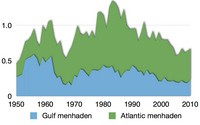 Global commercial capture of menhaden in million tonnes 1950–2010
Global commercial capture of menhaden in million tonnes 1950–2010
-
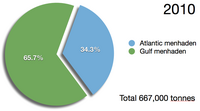 Capture of menhaden in 2010 reported by the FAO
Capture of menhaden in 2010 reported by the FAO
Uses for menhaden oil
Despite not being a popular fish for consumption, menhaden oil has many uses not only for humans but also for other animals. One element of menhaden oil is that it is high in omega-3 fatty acids. This molecule helps with lowering blood pressure, fixing abnormal heartbeats, reducing the chance of a heart attack or stroke, and other health benefits. It is due to this that menhaden oil can be used in supplements to help with the previously mentioned issues.
One way that menhaden oil benefits animals is seen in chickens. When menhaden oil was given to chickens in their feed, they had a lower chance of fatty liver disease. This was because of menhaden oil's high omega-3 fatty acid content, which took the place of omega-6 fatty acid, which is not as beneficial to animals. Another animal that benefits from omega-3 in menhaden oil is guinea pigs. When given menhaden oil in feed guinea pigs were shown to have a longer life span.
Risks of overfishing
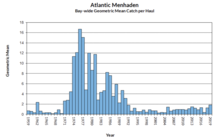
According to the Chesapeake Bay Foundation, menhaden are the most important fish in the Bay. This is because they are a food source for many commercial important species like striped bass. They also manage the algal bloom occurrences in the Bay because they eat phytoplankton. Decreases in menhaden populations could also leave striped bass vulnerable to disease. In the past 20 years, the number of juvenile menhaden produced in the Chesapeake Bay have been decreasing (Refer to Atlantic Menhaden Graph on bay-wide mean catch per haul).
This is believed to be due to the overfishing of menhaden for their fish oil. This could seriously disrupt the food chain. In response, the Atlantic States Marine Fisheries Commission (ASMFC) put a cap on the Atlantic menhaden harvest in October 2020. This 10% cut to the harvest is the first to ever be seen for menhaden coast-wide. It also was the first vote to consider benchmarks known as "ecological reference points". This allows managers to account for a species role in the food chain when setting catch limits. This is different from the "single-species stock assessments" that were previously used which only accounted for the demand from the fishing industry rather than the demand from the food web. This cut to the harvest established a quota of 194,400 metric tons of menhaden for the 2021–2022 fishing season. It is the hope that this cut will allow menhaden to fulfill their role in the ecosystem while keeping the commercial fishery alive.
Cultural significance
After menhaden had been identified as a valuable alternative to whale oil in the 1870s, the menhaden fishery on the Chesapeake was worked by predominantly African-American crews on open boats hauling purse seines. The men employed sea chanties to help synchronize the hauling of the nets. These chanties pulled from West African, blues, and gospel sources and created a uniquely African American culture of chanty singing. By the late 1950s, hydraulic winches replaced the large crews of manual haulers, and the menhaden chanty tradition declined.
Notes
- Franklin, H. (2007). The Most Important Fish in the Sea. Island Press. ISBN 978-1-59726-124-1.
- ^ Conniff, Richard (7 December 2012). "The Oiliest Catch". Conservation Magazine. University of Washington. Archived from the original on 31 January 2016. Retrieved 18 January 2013.
- Anderson, Joel D. (2007). "Systematics of the North American menhadens: molecular evolutionary reconstructions in the genus Brevoortia (Clupeiformes: Clupeidae)" (PDF). Fishery Bulletin. 105 (3): 368–378. Archived from the original (PDF) on 21 July 2011. Retrieved 10 February 2011.
- VanderKooy, Steven J.; Smith, Joseph W., eds. (March 2002). The Menhaden Fishery of the Gulf of Mexico, United States: A Regional Management Plan (PDF) (Report). Gulf States Marine Fisheries Commission. pp. 3–10. Archived (PDF) from the original on 3 March 2019.
- Friedland, Kevin D.; Lynch, Patrick D.; Gobler, Christopher J. (November 2011). "Time Series Mesoscale Response of Atlantic Menhaden Brevoortia tyrannus to Variation in Plankton Abundances". Journal of Coastal Research. 27 (6): 1148–1158. doi:10.2112/JCOASTRES-D-10-00171.1. S2CID 131569331.
- ^ Tavee, Tom; Franklin, H. Bruce (1 September 2001). "The Most Important Fish in the Sea". Discover. Archived from the original on 8 August 2018.
- "Maryland Department of Natural Resources". Dnr.state.md.us. 31 December 2012. Retrieved 7 January 2013.
- "FAO Fisheries & Aquaculture – Aquatic species". fao.org. Retrieved 4 December 2020.
- ^ Reintjes, John W. (November 1969). FAO Species Synopsis No. 42: Synopsis of Biological Data on the Atlantic Menhaden, Brevoortia tyrannus (PDF). Food and Agriculture Organization of the United Nations (Report). Washington, DC: U.S. Department of the Interior, U.S. Fish and Wildlife Service, Bureau of Commercial Fisheries. Circular 320. Archived (PDF) from the original on 29 November 2020. Retrieved 14 November 2022.
- ^ Greenberg, Paul (15 December 2009). "A Fish Oil Story". The New York Times. Archived from the original on 7 February 2019. Retrieved 10 February 2011.
- Addendum III to Amendment 1 to the Interstate Fishery Management Plan for Atlantic Menhaden (PDF) (Report). Atlantic States Marine Fisheries Commission. November 2006. pp. 2–3. Archived (PDF) from the original on 8 April 2015. Retrieved 24 March 2019.
- Addendum IV to Amendment 1 to the Atlantic Menhaden Fishery Management Plan (PDF) (Report). Atlantic States Marine Fisheries Commission. November 2009. p. 3. Archived (PDF) from the original on 18 March 2019.
- Amendment 2 to the Interstate Fishery Management Plan for Atlantic Menhaden (PDF) (Report). Atlantic States Marine Fisheries Commission. December 2012. pp. 47, 55. Archived (PDF) from the original on 18 March 2019.
- ^ Fairbrother, Alison (31 March 2013). "Omega Protein makes good on threat to cut jobs; but it doesn't have to". Bay Journal. Archived from the original on 29 June 2017.
- Addendum I to Amendment 2 of the Atlantic Menhaden Interstate Fishery Management Plan (PDF) (Report). Atlantic States Marine Fisheries Commission. August 2016. Archived (PDF) from the original on 18 March 2019.
- Amendment 3 to the Interstate Fishery Management Plan for Atlantic Menhaden (PDF) (Report). Atlantic States Marine Fisheries Commission. November 2017. p. iii, v. Archived (PDF) from the original on 18 March 2019.
- ^ Bittenbender, Steve (7 May 2018). "Omega Protein critical of ASMFC actions on Chesapeake menhaden". SeafoodSource. Archived from the original on 24 March 2019. Retrieved 24 March 2019.
- ^ Based on data sourced from the relevant FAO Species Fact Sheets
- Hargis, P.S.; Van Elswyk, M.E.; Hargis, B.M (1 April 1991). "Dietary Modification of Yolk Lipid with Menhaden Oil". Poultry Science. 70 (4): 874–883. doi:10.3382/ps.0700874. ISSN 0032-5791. PMID 1908579.
- ^ Anderson, Harold (January–February 2000). "Menhaden Chanteys: An African American Maritime Legacy" (PDF). Maryland Marine Notes. 18 (1). College Park, Maryland: Maryland Sea Grant College: 1–6. Archived (PDF) from the original on 24 March 2019.
- Mascioli, E A; Iwasa, Y; Trimbo, S; Leader, L; Bistrian, B R; Blackburn, G L (1 February 1989). "Endotoxin challenge after menhaden oil diet: effects on survival of guinea pigs". The American Journal of Clinical Nutrition. 49 (2): 277–282. doi:10.1093/ajcn/49.2.277. ISSN 0002-9165. PMID 2492743.
- "Atlantic Menhaden". cbf.org. Retrieved 10 December 2020.
- ^ "Atlantic Menhaden". cbf.org. Retrieved 9 December 2020.
- ^ "Fisheries Panel Cuts Atlantic Menhaden Harvest by 10 Percent". cbf.org. Retrieved 9 December 2020.
References
- "Brevoortia". Integrated Taxonomic Information System. Retrieved 6 June 2006.
- Pauly, Daniel (2 November 2007). "Fisheries: Tales of a small, but crucial, fish" (PDF). Science. 318 (5851): 750–751. doi:10.1126/science.1147800. S2CID 129523541. Archived (PDF) from the original on 4 July 2017. Retrieved 23 March 2019.
- "Useful menhaden links". Menhaden Matter. Archived from the original on 16 May 2008. Retrieved 20 April 2008.
- "Atlantic Menhaden Management". Chesapeake Bay Program. Archived from the original on 26 April 2008. Retrieved 20 April 2008.
- Fote, Thomas P. (21 April 1997). Interactions of Striped Bass, Bluefish and Forage Species (Speech). Congressional Testimony. Jersey Coast Anglers Association. Archived from the original on 2 May 2016. Retrieved 23 March 2019.
- "Geartype Fact Sheets: Purse Seines". Food and Agriculture Organization of the United States. Archived from the original on 27 March 2018. Retrieved 20 April 2008.
- Kirkley, James E. (2006). The Economic Importance and Value of Menhaden in the Chesapeake Bay Region (Report). Gloucester Point, Virginia.
- "Management: Conflict & Competition". Menhaden Resource Council. Archived from the original on 9 May 2008. Retrieved 20 April 2008.
- "Maryland Fish Facts: Atlantic Menhaden". Maryland Department of Natural Resources. 5 April 2007. Archived from the original on 2 June 2008. Retrieved 20 April 2008.
- "Mycobacteriosis: Frequently Asked Questions". Virginia Institute of Marine Science. Archived from the original on 4 March 2008. Retrieved 20 April 2008.
- "Plankton". Enchanted Learning. Archived from the original on 23 May 2018. Retrieved 20 April 2008.
- "Save the Stripers: Menhaden Update". National Coalition for Marine Conservation. 24 October 2007. Archived from the original on 9 May 2008. Retrieved 20 April 2008.
- Southwich Associates, Inc.; Loftus, Andrew J. (February 2006). Menhaden Math: The Economic Impact of Atlantic Menhaden on Virginia's Recreational and Commercial Fisheries (PDF) (Report). American Sportfishing Association; Coastal Conservation Association; National Coalition for Marine Conservation; Theodore Roosevelt Conservation Partnership. Archived (PDF) from the original on 24 March 2019. Retrieved 20 April 2008.
- Virginia Institute of Marine Science (2009). Several menhaden research projects, currently unpublished.
- Durbin, Ann G.; Durbin, Edward G. (September 1998). "Effects of Menhaden Predation on Plankton Populations in Narragansett Bay, Rhode Island". Estuaries and Coasts. 21 (3): 449–465. doi:10.2307/1352843. JSTOR 1352843. S2CID 85155711. Retrieved 23 March 2019.
- Smith, Nathan G.; Jones, Cynthia M. (2007). Final Report to the VMRC and RFAB: What is the cause of menhaden recruitment failure? Quantifying the role of striped bass predation (PDF) (Report). RF 05-01. Archived (PDF) from the original on 3 August 2007. Retrieved 23 March 2019.
- Lynch, Patrick D. (December 2007). Feeding ecology of the Atlantic menhaden (Brevoortia tyrannus) in Chesapeake Bay (PDF) (Master's thesis). Virginia Institute of Marine Science. Archived (PDF) from the original on 18 March 2018. Retrieved 23 March 2019.
- Friendland, Kevin D.; Ahrenholz, Dean W.; Smith, Joseph W.; Manning, Maureen; Ryan, Julia (December 2006). "Sieving functional morphology of the gill raker feeding apparatus of Atlantic menhaden". Journal of Experimental Zoology Part A: Ecological Genetics and Physiology. 305 (12): 974–985. Bibcode:2006JEZA..305..974F. doi:10.1002/jez.a.348. PMID 17041916.
- "Saving Striped Bass by Managing Menhaden". Keep America Fishing. Archived from the original on 6 April 2011.
- 2006 Stock Assessment Report for Atlantic Menhaden (PDF) (Report). Atlantic States Marine Fisheries Commission. 26 September 2006. Archived from the original (PDF) on 26 September 2012.
- "Atlantic Menhaden". Atlantic States Marine Fisheries Commission. Archived from the original on 18 March 2019. Retrieved 23 March 2019.
- Menhaden Species Team (March 2011). Ecosystem-Based Fisheries Management in Chesapeake Bay: Atlantic Menhaden (PDF) (Report). College Park, Maryland: Maryland Sea Grant College. Archived (PDF) from the original on 24 December 2015. Retrieved 23 March 2019.
External links
- NOAA Fisheries | NMFS
- Atlantic States Marine Fisheries Commission | ASMFC
- Gulf States Marine Fisheries Commission | GSMFC
- Pengelly, Martin (2 March 2023). "'Never seen anything like it': fisherman's video captures shark feeding frenzy". The Guardian. Sharks feeding on a large pod of menhaden.
| Forage fish | ||||||
|---|---|---|---|---|---|---|
| Marine |
| 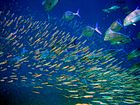 | ||||
| Freshwater |
| |||||
| Related topics | ||||||
| Principal commercial fishery species groups | ||||||||||||||||||||
|---|---|---|---|---|---|---|---|---|---|---|---|---|---|---|---|---|---|---|---|---|
| Wild |
|    | ||||||||||||||||||
| Farmed | ||||||||||||||||||||
| Taxon identifiers | |
|---|---|
| Brevoortia | |
| Ethmidium | |
